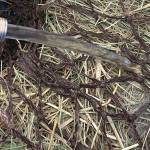10 Facts: Steaming and Soaking Your Horse’s Hay

Some horses require steamed or soaked hay for their well-being. Choosing which way to prepare hay depends on several factors, including expense, ease of operation and, most importantly, the horse’s health needs. Check out this list of considerations when deciding what’s best for your horse.
- Soaking and steaming reduce respirable dust particles significantly, sometimes completely. These particles originate from bacteria, molds, fungal spores, organic dust, minute plant structures, and insect fragments. When inhaled, the particles can stimulate hypersensitivity in your horse’s airways, contributing to inflammatory airway disease.
- Soaking hay reduces water-soluble carbohydrates (WSC) more than steaming. “Certain sugars and fructan identified during chemical analysis quantify the carbohydrate content of forages, and these are called water-soluble carbohydrates,” explained Catherine Whitehouse, M.S., a nutritionist for Kentucky Equine Research. “Fructans, the primary storage carbohydrate in cool-season grasses, are rapidly fermented in the hindgut rather than being digested in the small intestine like the sugar component of WSC.” The percent change in water-soluble carbohydrate losses in soaked hay can range from 8% to greater than 50%, but losses in steamed hay range from 0-18%. The variability in WSC after soaking or steaming does not guarantee the hay will be suitable for metabolic horses. Reducing WSC benefits overweight or obese horses on calorie-restricted diets. “Because of this, soaking hay relieves the need to aggressively restrict forage intake,” Whitehouse added. While decreasing forage intake reduces calorie intake, limiting forage means horses spend less time eating. Fasting puts horses at risk for gastric ulcers and the development of stereotypic behaviors. By reducing WSC, horses can be offered a larger portion of hay, allowing them to eat for more hours. Cutting WSC in hay also benefits horses with metabolic disorders such as insulin dysregulation, metabolic syndrome, polysaccharide storage myopathy, and pituitary pars intermedia dysfunction. Horses with chronic laminitis, often considered a complication of metabolic disorders, also profit from decreasing dietary WSC.
- Prolonged soaking leaches nutrients from the hay. Soaking for 15-30 minutes will reduce WSC without resulting in nutrient deficiencies. “If extended soaking is required, particularly for horses on restricted hay diets, offering a vitamin and mineral supplement or ration balancer is essential to ensure optimal nutrition to support health and performance,” recommended Whitehouse. Kentucky Equine Research offers vitamin and mineral supplements to help balance the diet, particularly for those on all-forage diets.
- Steaming preserves the minerals, trace elements, and crude protein in hay but does not result in any substantial changes in WSC and therefore may not benefit horses with metabolic disorders as much as soaking.
- Steaming hay reduces bacterial counts almost entirely. This benefits horses with respiratory compromise and may also support a healthier hindgut. “The health of the horse depends largely on the health of the intestinal microbiome. Microbial contamination in a horse’s feed could upset the delicate balance of microbes in the hindgut, leading to dysbiosis and related conditions such as colic and colitis,” Whitehouse warned.
- In contrast, soaking hay increases bacterial counts and is considered less hygienic than steaming hay unless fed directly after soaking. Whitehouse added, “It is important to consider optimal soaking times, amount of hay to soak at a time and handling and storage of soaked hay.” Generally speaking, hay should be fed as soon after removal from water as possible.
- The water used to soak the hay has a higher potential for environmental pollution and should be disposed of properly.
- Both steamed and soaked hays are consumed more slowly than dry forage. This can extend the length of time that horses spend eating each day, which can be advantageous for horses on calorie-restricted diets.
- Horses chew soaked hay more intensely than either dry or steamed hay. “Chewing forage increases the production of saliva, which can help buffer the stomach and support digestive health,” Whitehouse said. Increased chewing may also help a horse’s dental health.
- Horses appear to prefer steamed hay over soaked hay in terms of palatability.
If steamed or soaked hay is part of your horse’s diet, work with your veterinarian to decide which method will work best for your horse. If soaking or steaming hay is part of a respiratory-health plan, consider supplementing with a marine-derived source of omega-3 fatty acids, such as EO-3, a treatment favored by veterinarians.
Glatter, M., M. Bochnia, M. Wensch-Dorendorf, J.M. Greef, and A. Zeyner. 2021. Feed intake parameters of horses fed soaked or steamed hay and hygienic quality of hay stored following treatment. Animals (Basel):11(9):2729.








